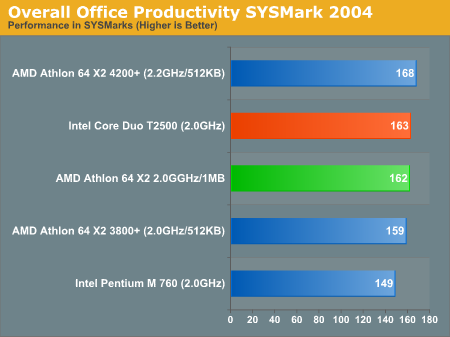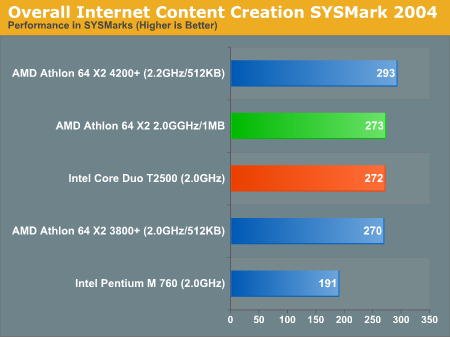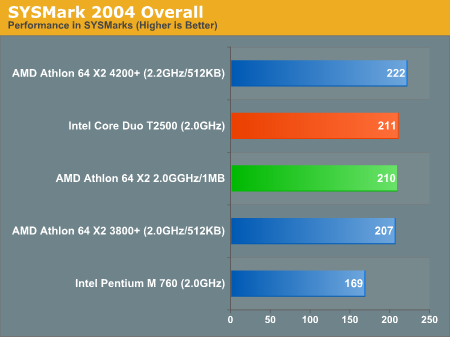Intel Core Duo (Yonah) Performance Preview - Part II
by Anand Lal Shimpi on December 19, 2005 12:55 PM EST- Posted in
- CPUs
Overall System Performance using SYSMark 2004
Office Productivity SYSMark 2004
SYSMark's Office Productivity suite consists of three tests, the first of which is the Communication test. The Communication test consists of the following:
Compared to the Athlon 64 X2, the Core Duo T2500 manages to slightly outperform the X2 3800+, but moving to a larger cache helps the X2 narrow that already small gap. Even though the Core Duo has a one-point lead, given the percentage, we'd call this one a tie.
The breakdown of the Office Productivity SYSMark 2004 score is listed below, higher numbers mean better performance:
ICC SYSMark 2004
The first category that we will deal with is 3D Content Creation. The tests that make up this benchmark are described below:
The breakdown of the ICC SYSMark 2004 score is listed below, higher numbers mean better performance:
Office Productivity SYSMark 2004
SYSMark's Office Productivity suite consists of three tests, the first of which is the Communication test. The Communication test consists of the following:
"The user receives an email in Outlook 2002 that contains a collection of documents in a zip file. The user reviews his email and updates his calendar while VirusScan 7.0 scans the system. The corporate web site is viewed in Internet Explorer 6.0. Finally, Internet Explorer is used to look at samples of the web pages and documents created during the scenario."The next test is Document Creation performance:
"The user edits the document using Word 2002. He transcribes an audio file into a document using Dragon NaturallySpeaking 6. Once the document has all the necessary pieces in place, the user changes it into a portable format for easy and secure distribution using Acrobat 5.0.5. The user creates a marketing presentation in PowerPoint 2002 and adds elements to a slide show template."The final test in our Office Productivity suite is Data Analysis, which BAPCo describes as:
"The user opens a database using Access 2002 and runs some queries. A collection of documents are archived using WinZip 8.1. The queries' results are imported into a spreadsheet using Excel 2002 and are used to generate graphical charts."

Compared to the Athlon 64 X2, the Core Duo T2500 manages to slightly outperform the X2 3800+, but moving to a larger cache helps the X2 narrow that already small gap. Even though the Core Duo has a one-point lead, given the percentage, we'd call this one a tie.
The breakdown of the Office Productivity SYSMark 2004 score is listed below, higher numbers mean better performance:
| OP SYSMark 2004 Score Breakdown | AMD Athlon 64 X2 4200+ | AMD Athlon 64 X2 3800+ | AMD Athlon 64 X2 2.0GHz/1MB | Intel Core Duo T2500 | Intel Pentium M 760 |
| Communication | 148 | 144 | 146 | 146 | 140 |
| Document Creation | 219 | 204 | 211 | 215 | 203 |
| Data Analysis | 145 | 136 | 138 | 138 | 117 |
ICC SYSMark 2004
The first category that we will deal with is 3D Content Creation. The tests that make up this benchmark are described below:
"The user renders a 3D model to a bitmap using 3ds max 5.1, while preparing web pages in Dreamweaver MX. Then the user renders a 3D animation in a vector graphics format."Next, we have 2D Content Creation performance:
"The user uses Premiere 6.5 to create a movie from several raw input movie cuts and sound cuts and starts exporting it. While waiting on this operation, the user imports the rendered image into Photoshop 7.01, modifies it and saves the results. Once the movie is assembled, the user edits it and creates special effects using After Effects 5.5."The Internet Content Creation suite is rounded up with a Web Publishing performance test:
"The user extracts content from an archive using WinZip 8.1. Meanwhile, he uses Flash MX to open the exported 3D vector graphics file. He modifies it by including other pictures and optimizes it for faster animation. The final movie with the special effects is then compressed using Windows Media Encoder 9 series in a format that can be broadcast over broadband Internet. The web site is given the final touches in Dreamweaver MX and the system is scanned by VirusScan 7.0."

The breakdown of the ICC SYSMark 2004 score is listed below, higher numbers mean better performance:
| ICC SYSMark 2004 Score Breakdown | AMD Athlon 64 X2 4200+ | AMD Athlon 64 X2 3800+ | AMD Athlon 64 X2 2.0GHz/1MB | Intel Core Duo T2500 | Intel Pentium M 760 |
| 3D Content Creation | 271 | 248 | 251 | 264 | 181 |
| 2D Content Creation | 340 | 312 | 314 | 323 | 238 |
| Web Publication | 274 | 254 | 257 | 236 | 162 |











103 Comments
View All Comments
fitten - Tuesday, December 20, 2005 - link
Yup... as I posted above... the rumor is that Yonah was designed for 2.5GHz (maybe even 2.6GHz or so) and can easily be overclocked to those speeds but is being launched at the speeds it is for exactly what you say... to fit in a certain power envelope.Xenoterranos - Tuesday, December 20, 2005 - link
We'll, that's definitely a logical argument, but I'd say only marginally relavent to this discussion. If a laptop with X% better power consumption comes out, does it really matter in the end where those X% came from. I can see the validity in saying that maybe some of those optimizations are on the board and thus the CPU shouldn't be given all the credit, but lower consumption is lower consumption. But that's all hypothetical. The reality is that even without optimizations, the Pentium M would have enjoyed lower power consumption just by moving to the 65nm proccess, as would any proccessor. that's where most of that 30% came from. I'd venture to say that the board design provides 1 or 2 % max, and definitely within the margin of error.><eno
Xenoterranos - Tuesday, December 20, 2005 - link
Um, i got confused there a bit. I'm basically saying that the new "Core Duo" derives the majority of it's efficiency not from any architectual changes (although they do help a lot), but from the move to 65nm. When AMD makes that jump to (and if Intel hasn't already gone to 45nm) then you'll see AMD pull ahead in power consumption on all 65nm parts, if not performance as well. Remember, aside from the on-die controller, this new architecture is very similar to what AMD is doing. Like the author said, if they wanted to copy something, they should at least copy the serial bus!Betwon - Tuesday, December 20, 2005 - link
All one know that Dothan is 90nm.But it is very cool. hot == Intel's 90nm? No!The CPU's architecture of low power consume is key. We must understand that IC design is very complex, many advanced tech are applied to keep CPU cool, include the CPU's architecture(such as micro-ops fusion).
Furen - Tuesday, December 20, 2005 - link
Yonah is better? It seems to be like its a pretty even match clock-for-clock but if you consider that X2s max out at 2.4GHz (currently) and Yonah will launch in around 15 days at 2.13GHz (the FX-60 is supposed to launch around the same time, so the X2 max clock may hit 2.6GHz when Yonah arrives) then it is clearly inferior in the performance department. Granted, the power consumption is quite a bit better but I'd hardly say that the CPU is better, just better suited for low-power applications.Betwon - Tuesday, December 20, 2005 - link
Yonah(2GHz/L2 2M) is better than AthonX2(2GHz/L2 2M) in the many cases.Everyone also believe that Yonah is able to reach the very high frequency.
In the past, We also known that PM can be overclocked better than A64. The PM's best record of Super Pi is much fast than A64/FX.
Zebo - Monday, December 19, 2005 - link
Yonah Yonah Yonah... Nah it was hype as I suspected... these procesors are vitually identical to AMD's old A-64's.. AMD supposed to get signifigant bumps w. DDR2/3 and PCIe onboard plus I read about some technology AMD and IBM made to increase performance by a whopping 40%!!http://www.guru3d.com/newsitem.php?id=3370">http://www.guru3d.com/newsitem.php?id=3370
AMD has nothing to fear other than in power arena when longer pipe Conroe comes and even then that advantage may very well disappear.
IntelUser2000 - Tuesday, December 20, 2005 - link
The 40% advantage is TRANSISTOR performance. Even then, its 40% advantage when no straining is included at all. AMD has strained silicon in their current process. Which means real advantage is FAR less than 40%.Shintai - Monday, December 19, 2005 - link
PCIe onboard is not a speed advantage. It´s more a tactic move towards the the computer on a chip solution.AMD is keen on ondie memory controller and in some years PCIe aswell due to the fact they suck at chipsets. Sure nVidia is making some good ones now. But it´s always been Intels extra strong point.
PCIe would also gives less traces on the motherboard that gives lower cost. But your CPU will break the 1300pin mark atleast and will be unable to scale in any way. Like AMDs backwards setting with DDR. When some new PCIe or more PCIe lanes comes out. You would need a new socket.
However personally I´m in favour of it. I just think AMDs ondie solutions is the wrong way. On package seems alot better and more flexible. Until we have an even more stagnant development cycle for external parts.
stateofbeasley - Monday, December 19, 2005 - link
DDR2 advantage? I wouldn't count on it. The latency on DDR2 still sucks compared to DDR. I wouldn't be so quick to scoff - Yonah performs as well as the X2 while consuming only a fraction of the electrical power.I don't see why people thought Yonah was going to be some sort of X2 destroyer. Its execution core has far fewer units than K8 and it lacks an on-die memory controler. The fact that it can match an X2 with slimmer cores makes it all the more impressive. The only hype was in your mind.
The AMD/IBM technology is not in processors that we can benchmark today -- they have yet to bring this process to mass manufacturing.